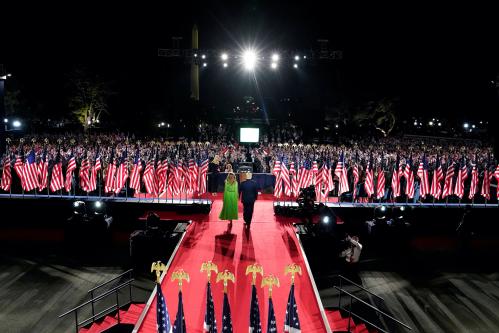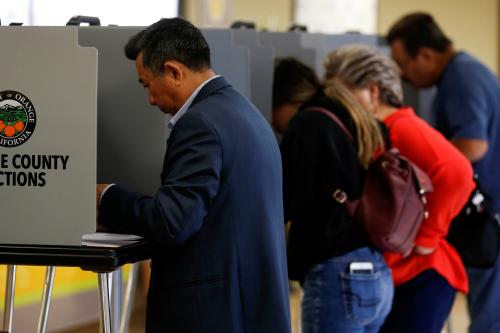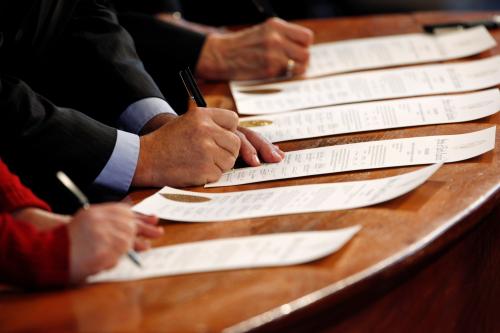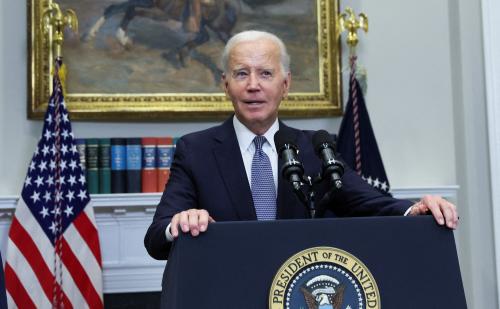The 2016 election was a bracing reminder that the presidency is won or lost in the states and not in the national popular vote. Donald Trump lost nationally by 2.9 million votes (2.1% of the total cast) while winning a comfortable Electoral College majority.
Can he repeat this feat in 2020? Yes. Can he do it if he loses than national popular vote by a larger margin than four years ago? Probably not. To win reelection, President Trump will have to reduce Joe Biden’s national vote advantage, which now stands at more than 10 percentage points, by about 8 points during the final two weeks of the campaign, an accomplishment for which there’s no clear precedent in American history. If he falls just short of replicating his 2016 showing, the country could be plunged into a dangerous political and legal struggle combining the worst features of 2000 and 1876.
Having learned their lesson in 2016, when pollsters for various media companies had pretty good estimates of the eventual national vote but missed significantly in what turned out to be the crucial states, survey researchers are doing more polls with higher quality in the swing states this year. This enables us to gauge with some confidence the current situation in the 13 states that could conceivably swing into either party’s column, either now or at some point in 2020.
Table 1: Biden lead in swing states
| State | Biden lead (deficit) [Percentage points] |
| Arizona | 3.8 |
| Florida | 4.1 |
| Georgia | 1.2 |
| Iowa | 0.2 |
| Michigan | 7.5 |
| Minnesota | 9.1 |
| Nevada | 6.5 |
| New Hampshire | 11.5 |
| North Carolina | 3.1 |
| Ohio | (0.1) |
| Pennsylvania | 6.9 |
| Texas | (1.4) |
| Wisconsin | 7.7 |
Source: FiveThirtyEight
As of now, Joe Biden leads in 11 of these 13 states. By contrast, Donald Trump won ten of them in 2016 and Hillary Clinton only three (New Hampshire, Minnesota, and Nevada). Of these three states, Biden’s lead in New Hampshire and Minnesota is too large to surmount, barring a political earthquake. Trump has an outside chance to prevail in only one Clinton state—Nevada—and to do so, he would have to improve his current standing substantially.
Looking at the current swing state polling against the backdrop of the national popular vote average enables us to project four possible scenarios.
Scenario 1. Trump cuts Biden’s lead in half
Suppose that the non-stop live-event campaign the Trump team has planned cuts Joe Biden’s lead in half, from 10 points to 5. In this scenario, Trump would win the two states where he currently leads—Ohio and Texas—and would pick up Arizona, Florida, Georgia, Iowa, and North Carolina. Michigan, Pennsylvania, Wisconsin, and Nevada would remain in the Biden column. President Trump would win 258 electoral votes, 12 short of a majority.
Scenario 2. Trump cuts Biden’s lead to 4 points
Suppose President Trump does even better, cutting Biden’s popular vote lead to just 4 points. It turns out that this would have no effect on Electoral College outcome, because Biden would still carry the three midwestern “Blue Wall” states plus Nevada.
Scenario 3. Trump cuts Biden’s lead to 2 points
Suppose President Trump’s campaign is so effective that he cuts Biden’s popular vote margin to just 2 points, replicating the 2016 results. In this event, Trump would carry all the states he won in 2016 plus Nevada—a total of 312 electoral votes.
Scenario 4: The nightmare
Suppose President Trump cuts Biden’s lead to 3 points. Although Nevada probably would fall into his hands, Pennsylvania would be too close to call. In this event, the state that most observers believe has the highest potential for electoral delays and snafus in counting mail-in ballots would determine the outcome of the race. This would all but guarantee a replay of the Florida controversy in 2000 that ended with Bush v. Gore, but with a much higher level of partisan polarization, more intense divisions over the legitimacy of the Supreme Court, and heightened threats of civil disorder. While it may not reach the level of rancor following the disputed 1876 election—when the post-Civil War Reconstruction era came to its bitter end—it could make the disputed 2000 election look tame by comparison.
There’s an obvious objection to my analysis: I’ve assumed that shifts in the national popular vote would be evenly distributed across the states. Isn’t it possible that the swing states might diverge significantly from the national average?
While no one can rule this out, there’s important evidence to the contrary. The 4.3 percentage-point reduction in President Trump’s support between 2016 and today has been distributed remarkably evenly among the swing states, as shown in Table 2.
Table 2
| State | Trump 2016 | Trump 2020 | Difference |
| Arizona | 48.7 | 45.2 | 3.5 |
| Florida | 49.0 | 45.1 | 3.9 |
| Georgia | 50.8 | 46.6 | 4.2 |
| Iowa | 51.2 | 47.5 | 3.7 |
| Michigan | 47.5 | 42.8 | 4.7 |
| Minnesota | 44.9 | 41.7 | 3.2 |
| Nevada | 46.0 | 43.2 | 2.8 |
| New Hampshire | 46.6 | 42.2 | 4.4 |
| North Carolina | 49.8 | 45.9 | 3.9 |
| Ohio | 51.7 | 47.1 | 4.6 |
| Pennsylvania | 48.2 | 44.0 | 4.2 |
| Texas | 52.2 | 48.5 | 3.7 |
| Wisconsin | 47.2 | 43.1 | 4.1 |
Sources: State Secretaries of State; FiveThirtyEight
The bottom line: with only one outlier (Nevada), the change in President Trump’s support between 2016 and 2020 has been remarkably uniform, both among the swing states and between those states and the rest of the country. Although the electoral college results will be determined by the individual states, the 2020 election is being shaped much more by national factors than by differences among the states. The implication is that President Trump will not be able to overcome Joe Biden’s current Electoral College lead, which is substantial, unless he can reduce Biden’s national popular vote advantage to roughly the 2-point difference of 2016. The worst-case outcome is that Trump gets close to this result without equaling it, leaving the outcome of the election in doubt and throwing the country into chaos under highly adverse circumstances.







Commentary
Can President Trump win an Electoral College majority in 2020?
October 19, 2020